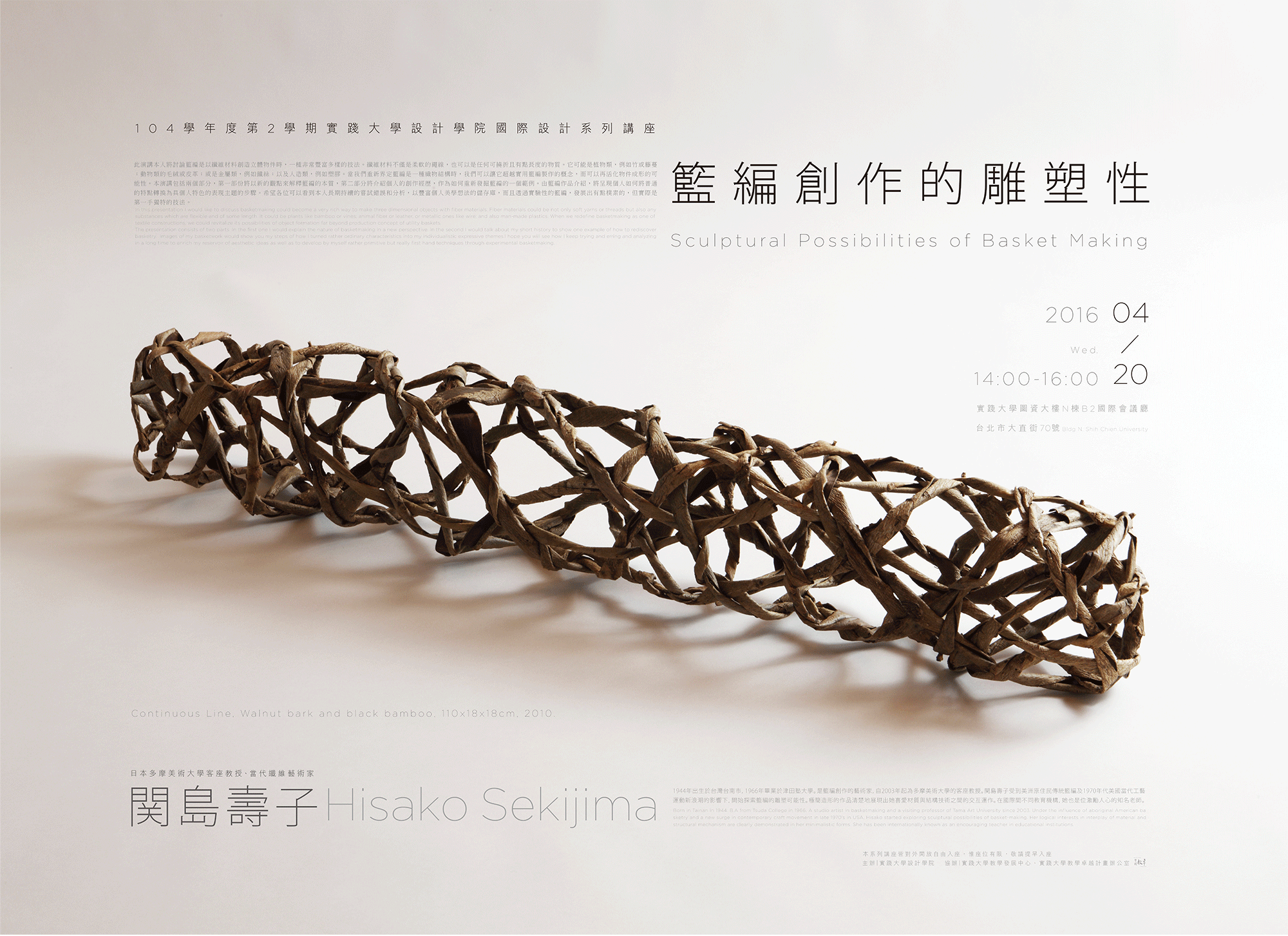講題:Sculptural Possibilities of Basket Making(籃編創作的雕塑性)
講者:關島壽子 Hisako Sekijima (籃編創作藝術家;多摩美術大學的客座教授)
時間:2016/4/20 14:00-16:00
地點:實踐大學台北校區NB2國際會議廳
※本系列講座對外開放,歡迎外校人士蒞臨參與,唯座位有限敬請提早入座。
此演講將討論籃編是以纖維材料創造立體物件時,一種非常豐富多樣的技法。纖維材料不僅是柔軟的繩線,也可以是任何可撓折且有點長度的物質。它可能是植物類,例如竹或籐蔓;動物類的毛絨或皮革;或是金屬類,例如鐵絲;以及人造類,例如塑膠。當我們重新界定籃編是一種織物結構時,我們可以讓它超越實用籃編製作的概念,而可以再活化物件成形的可能性。
本演講包括兩個部分,第一部份將以新的觀點來解釋籃編的本質,第二部分將介紹個人的創作經歷,作為如何重新發掘籃編的一個範例。由籃編作品介紹,將呈現個人如何將普通的特點轉換為具個人特色的表現主題的步驟。希望各位可以看到本人長期持續的嘗試錯誤和分析,以豐富個人美學想法的儲存庫,而且透過實驗性的籃編,發展出有點樸素的,但實際是第一手獨特的技法。
In this presentation I would like to discuss basketmaking could become a very rich way to make three dimensional objects with fiber materials. Fiber materials could be not only soft yarns or threads but also any substances which are flexible and of some length. It could be plants like bamboo or vines; animal fiber or leather, or metallic ones like wire; and also man-made plastics. When we redefine basketmaking as one of textile constructions, we could revitalize its possibilities of object formation far beyond production concept of utility baskets.
The presentation consists of two parts. In the first one I would explain the nature of basketmaking in a new perspective. In the second I would talk about my short history to show one example of how to rediscover basketry. Images of my basketwork would show you my steps of how I turned rather ordinary characteristics into my individualistic expressive themes. I hope you will see how I keep trying and erring and analyzing in a long time to enrich my reservoir of aesthetic ideas as well as to develop by myself rather primitive but really first hand techniques through experimental basketmaking.
講者介紹:
関島壽子 Hisako Sekijima
1944年出生於台灣台南市,1966年畢業於津田塾大學。是籃編創作的藝術家,自2003年起為多摩美術大學的客座教授。関島壽子受到美洲原住民傳統籃編及1970年代美國當代工藝運動新浪潮的影響下,開始探索籃編的雕塑可能性。極簡造形的作品清楚地展現出她喜愛材質與結構技術之間的交互運作。在國際間不同教育機構,她也是位激勵人心的知名老師。
Born in Tainan in 1944. B.A from Tsuda College in 1966. A studio artist in basketmaking and a visiting professor of Tama Art University since 2003. Under the influence of aboriginal American basketry and a new surge in contemporary craft movement in late 1970’s in USA, Hisako started exploring sculptural possibilities of basket-making. Her logical interests in interplay of material and structural mechanism are clearly demonstrated in her minimalistic forms. She has been internationally known as an encouraging teacher in educational institutions.
